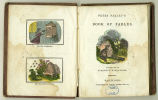Fables
After the Bible, perhaps the oldest text to be shared by adults with their children is that of Aesop's Fables. Most sources describe Aesop as a former Greek slave living in the 6th century BC (Herodotus). The fables attributed to Aesop were passed down through oral tradition. Perhaps Socrates did spend his time in jail turning them into verse (Plato). They were translated from the Greek to Latin by Phaedrus. We do know that there is a drawing of Aesop in the Nuremberg Chronicle and that William Caxton, the first English printer, produced a copy of Aesop's Fables in the 15th century. The use of personified animals and the separate moral at the end of each tale are very familiar to children of every generation as the tales continue to appear in new versions today.
 |
THE BABY'S OWN AESOP. By Walter Crane. London: George Routledge, 1871. The usual method of producing these books was as follows: the artist submitted his drawings to Evans, it would be photographed onto the wood block and Evans would engrave the keyblock. He would make as many impressions of the keyblock as the artist needed colors. The colored drawings were then returned to Evans and he would carve a block for each color. It was Crane's belief that "Children, like the ancient Egyptians, appear to see most things in profile, and like definite statement in design. They prefer well defined forms and bright frank color. They don't want to bother about three dimensions. They can accept symbolic representations...." Exhibit checklist 3.1 (View this item) |
 |
AESOP'S FABLES IN WORDS OF ONE SYLLABLE. By Mary Godolphin.
New York & London: George Routledge & Sons, [ca. 1887]. |
 |
ÆSOPI PHRYGIS ET ALIORUM FABULAE QUORUM NOMINA SEQUENS PAGELLA INDICABIT / PLURIBUSQUE AUCTAE & DILIGENTIUS QUAM ANTEHAC EMENDATAE [A MAXIMO PLANUDE]. Florentiae: Typis Regiae Celsitudinis, 1718. |
 |
PETER PARLEY'S BOOK OF FABLES. By Samuel Griswold
Goodrich. Hartford: White, Dwier & Co., 1834. |
 |
AESOP'S FABLES. New York: Samuel Wood & Sons; Baltimore: Samuel S. Wood & Co., 1818. |
 |
BEWICK'S SELECT FABLES OF AESOP AND OTHERS. London: Longmans, Green, and Co., 1878. |
 |
THE AESOP FOR CHILDREN WITH PICTURES BY MILO WINTER. Chicago: Rand McNally & Co., 1919. |

